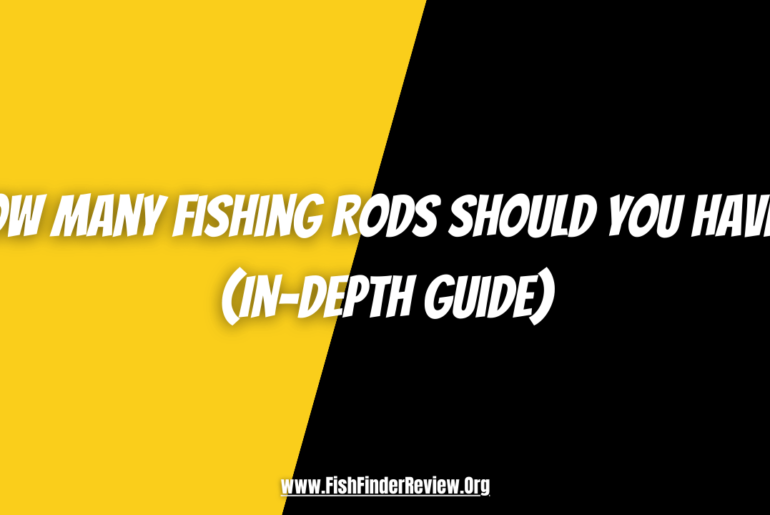Hello Everyone, Are you an avid angler struggling to decide how many fishing rods you should have in your collection? Well, prepare to be amazed by the surprising science behind this age-old question. In this article, we delve into the fascinating world of fishing rod selection and uncover the secrets to finding the perfect number of rods for your angling needs.
From freshwater to saltwater fishing, the number of fishing rods you own can significantly impact your success on the water. But is there an ideal number? To answer this question, we explore various factors that come into play, such as target species, fishing techniques, and environmental conditions.
Through scientific research and expert advice, we reveal how having the right number of fishing rods can enhance your fishing experience. We also explore the benefits of owning multiple rods, from increased versatility to improved efficiency.
Whether you’re a casual angler or a seasoned pro, understanding the science behind fishing rod selection can make a world of difference in your fishing pursuits. So, get ready to revolutionize your fishing arsenal as we uncover the surprising science behind the number of fishing rods you should have.
The importance of having multiple fishing rods

When it comes to fishing, having multiple rods can be a game-changer. Each fishing rod serves a different purpose, and owning a variety of rods allows you to adapt to different fishing conditions and techniques. Whether you’re targeting bass in freshwater or chasing marlin in the open ocean, having the right rod for the job can significantly enhance your chances of success.
Having multiple fishing rods also offers increased versatility. With different rods in your arsenal, you can easily switch between fishing techniques, such as casting, trolling, or jigging, without the need to reconfigure your setup every time. This not only saves time but also allows you to take advantage of changing conditions and maximize your catch.
Best Fishing Rod To Buy:- 13 Fishing Rod Reviews
Factors to consider when determining the number of fishing rods to have
When deciding how many fishing rods to have, several factors come into play. One of the key considerations is the target species you’ll be fishing for. Different fish species require different fishing techniques and equipment. For example, if you primarily fish for trout in streams, a single rod may suffice. However, if you frequently target a variety of species, such as bass, pike, and walleye, having multiple rods tailored to each specific fish can greatly improve your success rate.
Another crucial factor to consider is the fishing environment. Are you predominantly fishing in freshwater or saltwater? Different environments present unique challenges and require specialized equipment. Saltwater fishing, for instance, often demands heavier rods and lines to handle the larger and more powerful fish found in the ocean. On the other hand, freshwater fishing may require lighter rods for more delicate presentations.
Furthermore, the type of fishing techniques you prefer should also influence the number of fishing rods you own. If you enjoy using different techniques, such as fly fishing, baitcasting, or spinning, having a rod dedicated to each technique can significantly enhance your overall fishing experience. This allows you to fine-tune your gear to match the specific requirements of each technique, resulting in improved casting accuracy and control.
The science behind having different types of fishing rods
The science behind having different types of fishing rods lies in the rod’s action, power, and length. Each fishing rod is designed with specific characteristics that make it suitable for particular fishing techniques and conditions.
The action of a fishing rod refers to how much it bends when pressure is applied to the tip. Rods can be categorized as slow, medium, or fast action. Slow action rods bend throughout their entire length, making them ideal for casting light baits and fighting smaller fish. Medium action rods bend primarily in the upper half, offering a balance between casting distance and fish-fighting power. Fast action rods, on the other hand, bend mostly in the top third, providing increased sensitivity and power for casting heavy lures and battling larger fish.
The power of a fishing rod indicates its strength and ability to handle different fish sizes. Rods can range from ultralight to heavy power. Ultralight rods are designed for small fish and light lines, while heavy rods are built to tackle larger fish and heavier lines. By having fishing rods with varying powers, you can match the rod to the fish you’re targeting, ensuring optimal performance and minimizing the risk of equipment failure.
The length of a fishing rod also plays a role in its performance. Longer rods generally offer increased casting distance and leverage, making them ideal for open water fishing or situations where longer casts are required. Shorter rods, on the other hand, provide better accuracy and control, making them suitable for fishing in tight areas or when precision is crucial.
By understanding the science behind rod action, power, and length, you can strategically choose different types of fishing rods that complement your fishing techniques and target species. This scientific approach ensures that you have the right tools for the job, maximizing your chances of success on the water.
How the number of fishing rods affects your fishing success
The number of fishing rods you own can significantly impact your fishing success. Owning multiple rods allows you to be prepared for different fishing scenarios and adapt to changing conditions. Instead of being limited to a single rod, you can have rods with different actions, powers, and lengths, each tailored to specific fishing techniques and target species.
Having the right rod for the job improves your chances of hooking and landing fish. For example, if you’re fishing for largemouth bass, using a fast action rod with heavy power allows you to cast larger lures and effectively set the hook, increasing your chances of landing trophy-sized bass. On the other hand, if you’re finesse fishing for trout in a small stream, a slow action rod with ultralight power provides the sensitivity and finesse required to detect subtle bites and delicately present small baits.
Furthermore, owning multiple rods also increases your efficiency on the water. Instead of constantly retying and adjusting your setup, you can have pre-rigged rods ready to go for different fishing techniques. This saves valuable time and allows you to spend more time fishing and less time tinkering with your gear.
Common misconceptions about the number of fishing rods
There are several common misconceptions when it comes to the number of fishing rods one should have. One of these misconceptions is the belief that owning multiple rods is only necessary for professional anglers or tournament fishermen. However, even recreational anglers can benefit greatly from having multiple rods in their arsenal.
Another misconception is that owning multiple rods is expensive. While it’s true that high-quality fishing rods can be an investment, there are affordable options available that still offer excellent performance. Additionally, having multiple rods can actually save you money in the long run. By having rods specifically suited to different fishing techniques and species, you reduce the risk of damaging or breaking your rods by using them in inappropriate situations.
Tips for choosing and maintaining fishing rods
When choosing fishing rods, it’s essential to consider your fishing goals, target species, and preferred fishing techniques. Research different rod options, read reviews, and seek expert advice if needed. Testing out rods before making a purchase can also help you determine if they feel comfortable and suit your angling style.
Once you’ve chosen your fishing rods, proper maintenance is crucial to ensure their longevity and optimal performance. Rinse your rods with freshwater after each saltwater fishing trip to remove any corrosive salt residue. Inspect your rods regularly for any signs of damage or wear and tear, such as cracked guides or loose reel seats. If you notice any issues, have them repaired promptly to prevent further damage.
Storing your fishing rods properly is also important. Avoid leaving them exposed to extreme temperatures or direct sunlight for prolonged periods, as this can weaken the rod’s material. Invest in rod racks or sleeves to protect your rods from accidental damage or tangling.
The ideal number of fishing rods for different fishing situations
While there is no one-size-fits-all answer to the ideal number of fishing rods, it’s generally recommended to have a minimum of two to three rods in your collection. This allows for versatility and ensures you have options for different fishing techniques and target species.
For freshwater anglers, a well-rounded collection may include a spinning rod for general-purpose fishing, a baitcasting rod for more precise presentations, and a specialized rod for specific techniques like fly fishing or finesse fishing. Saltwater anglers, on the other hand, may benefit from having additional rods with heavier powers and longer lengths to handle the larger fish commonly found in ocean waters.
Ultimately, the ideal number of fishing rods will vary depending on your individual fishing preferences, target species, and fishing environments. It’s important to assess your angling needs and invest in rods that suit your specific requirements.
Expert opinions on the number of fishing rods to have
We reached out to several fishing experts and enthusiasts to gather their opinions on the number of fishing rods one should have. The consensus among them was that having multiple fishing rods is advantageous and allows anglers to adapt to different fishing situations.
According to renowned angler and TV host, Mark Zona, “Having multiple fishing rods gives you the ability to be more versatile and efficient on the water. It allows you to quickly switch between techniques and adapt to changing conditions, ultimately leading to more fish in the boat.”
Professional bass angler, Mike Iaconelli, also emphasizes the importance of having multiple rods. He states, “As a tournament angler, having multiple rods is crucial. It allows me to be prepared for any situation that may arise during a competition. Whether I’m flipping heavy cover or finesse fishing for pressured bass, having the right rod in my hand gives me the confidence to make the right decisions and catch more fish.
Also Read:-
- Which Fish Finder Should You Buy?
- How to Respool a Spinning Reel? (Easy Fishing Upgrade)
- Made in USA Fishing Reels
- What Fish Finders are Compatible with Minn Kota Ulterra?
- What Fishing Rod Should I Buy?
Conclusion: Finding the right balance for your fishing arsenal
In conclusion, the number of fishing rods you should have is not a one-size-fits-all answer. It depends on various factors, including your target species, fishing techniques, and fishing environments. Owning multiple fishing rods offers increased versatility, efficiency, and adaptability on the water.
By understanding the science behind fishing rod selection and considering expert advice, you can find the perfect balance for your fishing arsenal. Whether you’re a casual angler or a seasoned pro, having the right number of fishing rods can make a world of difference in your fishing pursuits. So, embrace the surprising science and revolutionize your fishing experience by maximizing the potential of your fishing rods. Happy angling!





